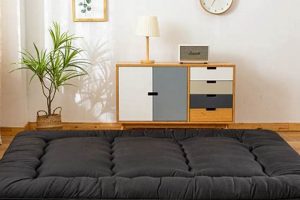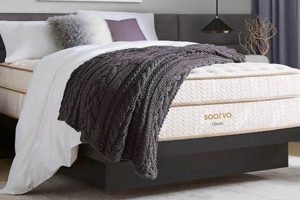The act of resting on an inflatable sleeping surface, commonly utilized for temporary accommodations or camping, presents both advantages and disadvantages. These portable beds offer convenience in terms of storage and transport, readily deflating for compact packing. However, the experience may differ significantly from that offered by a traditional mattress.
The appeal lies in their portability and affordability, making them suitable for guests, travel, or situations where a permanent bed is not feasible. Historically, inflatable beds have evolved from simple rubberized canvases to sophisticated designs incorporating features like internal pumps and enhanced materials for increased comfort and durability. Their significance is tied to their utility in providing temporary sleeping arrangements.
The subsequent sections will delve into various aspects associated with using these sleeping arrangements, including factors influencing comfort, potential health considerations, selection criteria, and methods for ensuring proper maintenance and longevity.
Tips for Optimal Rest
To enhance the experience, consider these recommendations regarding usage and care:
Tip 1: Regulate Inflation Levels: Over-inflation leads to a firm, uncomfortable surface. Under-inflation results in instability and potential contact with the floor. Adjust the air pressure to achieve a balance between support and cushioning. Test by sitting and lying down, gradually adding or releasing air as needed.
Tip 2: Employ a Mattress Topper: The addition of a foam or quilted topper significantly improves comfort by distributing weight more evenly and mitigating the cool surface temperature often associated with inflatable beds. Select a topper of appropriate size and thickness based on individual preferences.
Tip 3: Utilize Proper Bedding: Standard sheets may not fit snugly on these beds. Fitted sheets designed for air mattresses, or those with elasticized edges, are recommended. Use blankets or comforters to regulate temperature and prevent heat loss during the night.
Tip 4: Protect from Punctures: Select a clear, level surface, free from sharp objects. Place a protective barrier, such as a blanket or tarp, beneath the air mattress to guard against potential punctures from below. Avoid placing near sharp objects.
Tip 5: Monitor Temperature Fluctuations: Air volume inside the bed will change with temperature. Cooler temperatures may cause a decrease in pressure, while warmer temperatures may cause over-inflation. Adjust the air pressure as needed to compensate for environmental changes.
Tip 6: Consistent cleaning: Wipe the surface with a damp cloth and mild soap after each use. Allow the air mattress to fully dry before storing it. This prevents the buildup of mold and bacteria and helps to maintain the material’s integrity.
Implementing these suggestions can markedly improve the quality of rest and extend the lifespan of the inflatable sleeping surface.
The concluding section will address storage considerations and common troubleshooting techniques.
1. Inflation maintenance
Maintaining proper inflation levels is paramount to the overall utility and comfort derived from an inflatable sleeping surface. Inadequate or inconsistent inflation compromises the structural integrity of the sleeping arrangement, affecting its intended function and potentially leading to discomfort or instability.
- Impact on Spinal Alignment
Insufficient inflation causes the air mattress to sag, leading to improper spinal alignment during sleep. This misalignment can exacerbate existing back pain or contribute to the development of new musculoskeletal issues. Adequate inflation ensures a level and supportive surface, promoting neutral spinal posture.
- Influence on Sleep Quality
Fluctuations in air pressure throughout the night disrupt sleep patterns. Gradual air loss leads to a sinking sensation, causing the sleeper to awaken and readjust. Consistent inflation levels facilitate uninterrupted sleep cycles, contributing to improved rest quality.
- Effect on Material Stress
Over-inflation places undue stress on the seams and material of the air mattress, increasing the risk of rupture or leaks. Conversely, under-inflation subjects the material to creasing and friction, also weakening its integrity over time. Maintaining the recommended inflation level minimizes stress and extends the lifespan of the product.
- Correlation with Temperature Variations
Air volume within the air mattress is sensitive to ambient temperature. Cooler temperatures cause air to contract, resulting in decreased pressure and support. Warmer temperatures cause air to expand, potentially leading to over-inflation and increased firmness. Regular monitoring and adjustment of inflation levels are necessary to compensate for these temperature-induced changes.
The interplay between these aspects underscores the importance of vigilant inflation maintenance. Addressing these issues contributes to an improved, more comfortable, and potentially healthier experience while utilizing an inflatable sleeping surface. Regular monitoring and adjustment of the air pressure can significantly affect the quality of sleep and the lifespan of the air mattress.
2. Support distribution
The efficacy of resting on an air mattress is inextricably linked to its capacity for uniform weight dispersal. Insufficient or uneven weight distribution precipitates localized pressure points, causing discomfort and disrupting sleep. A key determinant of support distribution lies in the internal structure of the air mattress, which often incorporates baffles or coils designed to maintain consistent firmness across the surface. Air mattresses lacking these features tend to exhibit greater variability in support, with the center often sagging under the weight of the occupant. For example, a person lying on an air mattress with inadequate internal support may experience concentrated pressure on their hips and shoulders, potentially leading to pain or stiffness.
The material composition and inflation level further influence support distribution. Thicker, more durable materials resist deformation and contribute to a more stable sleeping surface. Over-inflation, however, can create an excessively firm surface, reducing contouring and exacerbating pressure points. Conversely, under-inflation leads to a lack of support, allowing the body to sink and potentially contact the floor. The practical application of understanding support distribution informs the selection of an air mattress that suits the individual’s body weight and sleeping position. Furthermore, adjusting the inflation level to achieve a balance between firmness and cushioning optimizes comfort.
In summary, the degree of weight dispersal provided is critical to the overall sleeping experience. Variations in this aspect can cause discomfort and interrupt rest. Choosing models with robust internal structures and selecting materials which resists deformation is one of the major keys in improving support, resulting in better sleep and an adequate choice for specific uses.
3. Temperature regulation
Temperature regulation represents a significant consideration when utilizing an inflatable sleeping surface. The material composition and design of these beds influence heat retention and dissipation, impacting sleep quality and comfort. The following points outline facets of temperature regulation pertinent to the experience.
- Material Conductivity
The primary material, typically PVC or similar polymer, possesses inherent thermal properties affecting heat transfer. PVC exhibits relatively low thermal conductivity, meaning it does not readily dissipate heat. Consequently, a user may experience increased warmth during sleep, particularly in warmer environments. The practical implication is the potential for overheating, which can disrupt sleep cycles.
- Air Circulation and Insulation
The enclosed air within the mattress acts as an insulator, reducing heat loss to the surrounding environment. While beneficial in colder conditions, this insulation can contribute to heat buildup in warmer climates. Lack of internal air circulation exacerbates this effect. For example, individuals in temperate climates could benefit from mattresses designed with enhanced airflow, reducing heat retention.
- Surface Contact Area
The extent of body contact with the mattress surface influences heat exchange. A larger contact area restricts airflow and promotes heat retention. Conversely, reduced contact facilitates ventilation and cooling. This factor highlights the importance of bedding choices. Breathable sheets and blankets can mitigate heat buildup, promoting a more comfortable sleep environment.
- Environmental Factors
Ambient temperature and humidity exert a direct influence on the thermal experience. In humid conditions, the reduced capacity for evaporative cooling increases the sensation of warmth. Conversely, in colder environments, the insulating properties of the mattress can provide a degree of thermal protection. Consequently, environmental considerations should inform the selection and usage of inflatable sleeping surfaces.
These multifaceted aspects of thermal dynamics collectively shape the sleeping experience. Addressing issues related to the temperature through careful material selection, the use of bedding and environmental awareness becomes important when choosing a comfortable inflatable sleeping surface, and will inevitably affect the quality of rest received.
4. Material durability
The longevity and performance of an air mattress are fundamentally contingent upon the durability of its constituent materials. Compromised material integrity precipitates air leakage, structural failure, and a diminished capacity to provide adequate support, thus rendering the product unsuitable for its intended purpose.
- Resistance to Puncture and Abrasion
Air mattresses are susceptible to punctures from sharp objects and abrasion from rough surfaces. The material’s inherent resistance to these external forces directly influences its lifespan. For instance, an air mattress constructed from thin PVC is more prone to puncture compared to one fabricated from reinforced nylon or multiple layers of composite materials. Consequently, the selection of materials with enhanced puncture and abrasion resistance is paramount for long-term use.
- Tensile Strength and Tear Resistance
The material must withstand internal pressure and external stresses without tearing or stretching excessively. Tensile strength, a measure of the material’s ability to resist being pulled apart, and tear resistance, its ability to resist tearing when punctured, are critical determinants of durability. Air mattresses subjected to repeated inflation and deflation cycles experience significant stress; materials with superior tensile strength and tear resistance maintain their structural integrity over extended periods.
- Seam Integrity and Welding Quality
The seams where different sections of the material are joined represent vulnerable points in the construction of an air mattress. Weak or poorly welded seams are prone to failure under pressure, leading to air leaks and structural instability. Therefore, the quality of the welding process and the strength of the seam adhesive are critical factors affecting material durability.
- Resistance to Environmental Degradation
Prolonged exposure to sunlight, temperature fluctuations, and humidity can degrade certain materials, leading to embrittlement, cracking, or discoloration. Air mattresses intended for outdoor use or storage should be constructed from materials resistant to these environmental factors. For example, UV-resistant coatings can protect against sunlight degradation, while materials with low moisture absorption prevent the growth of mold and mildew.
In conclusion, the expected performance from an air mattress significantly hinges on its materials’ capacity to withstand the stresses associated with inflation, use, and environmental exposure. Selecting a product constructed from robust, high-quality materials, is essential for optimizing its service life and maintaining a proper sleeping experience. Investing in models designed for resilience is key in ensuring long-term utility and minimizing potential failures.
5. Storage practicality
The inherent advantage of an air mattress lies not only in its provision of a temporary sleeping surface but also in its storage practicality when not in use. The ability to deflate and compactly store an air mattress distinguishes it from conventional beds, presenting a significant benefit for individuals with limited living space or those requiring a portable sleeping solution. The storage practicality directly affects the overall usability of an air mattress, influencing its appeal and suitability for various applications. For instance, a family living in a small apartment might opt for an air mattress to accommodate occasional guests, as it can be easily stored in a closet when not needed, unlike a traditional guest bed that would permanently occupy valuable floor space.
Considerations surrounding storage practicality extend beyond mere space-saving. The ease of deflation and packing, the durability of the deflated mattress during storage, and the protection from environmental factors such as moisture and temperature fluctuations are all relevant. A poorly designed air mattress that is difficult to deflate or fold compactly negates some of the advantages of its portable nature. Likewise, if the material is susceptible to damage from prolonged storage in a humid or cold environment, the mattress’s lifespan will be significantly reduced. Addressing these issues allows for efficient utilization in scenarios where limited space and portability is required.
In summary, storage practicality is an integral component of the utility and appeal of an air mattress. Its capacity to be efficiently stored when deflated is a key differentiator from conventional beds, offering solutions for space-constrained environments and temporary sleeping needs. Recognizing and addressing the factors that contribute to or detract from storage practicality is essential for maximizing the value and lifespan of an air mattress, ensuring it remains a convenient and readily available sleeping solution.
Frequently Asked Questions About Inflatable Sleeping Surfaces
The following addresses common inquiries regarding the use and considerations associated with inflatable sleeping surfaces.
Question 1: Is it advisable to utilize these surfaces as a long-term sleeping solution?
Prolonged use is generally discouraged due to potential ergonomic limitations. Traditional mattresses offer superior spinal support and pressure relief, promoting healthier sleep posture over extended periods.
Question 2: What measures mitigate the risk of puncture or air leakage?
Placement on a clear, level surface, free of sharp objects, is essential. The use of a protective barrier beneath the inflatable surface provides an additional layer of defense. Regular inspection for wear and tear is also advisable.
Question 3: How does temperature influence the comfort of these surfaces?
Ambient temperature directly affects the air pressure within. Cooler temperatures cause a decrease in pressure, potentially leading to discomfort. Warmer temperatures may result in over-inflation. Monitoring and adjustment of air pressure are necessary to compensate for these fluctuations.
Question 4: What types of bedding are most suitable for these surfaces?
Fitted sheets designed for air mattresses, or those with elasticized edges, provide a snug fit. Breathable fabrics promote airflow and regulate temperature. Avoid using bedding that is overly heavy or constricting.
Question 5: What is the recommended procedure for cleaning these surfaces?
Wipe the surface with a damp cloth and mild soap. Avoid harsh chemicals or abrasive cleaners. Allow the air mattress to fully dry before storing it. Regular cleaning prevents the buildup of mold, bacteria, and allergens.
Question 6: How should these surfaces be stored when not in use?
Deflate the mattress completely and fold it compactly. Store it in a cool, dry place, away from direct sunlight and extreme temperatures. Avoid placing heavy objects on top of the stored mattress.
Adherence to these guidelines can improve the safety, comfort, and longevity of inflatable sleeping surfaces.
The subsequent discussion will delve into a comparative analysis of various inflatable sleeping surface models.
In Conclusion
This exploration has illuminated diverse facets of sleeping on an air mattress, spanning from considerations of comfort and support to aspects of material durability and storage practicality. The objective analysis underscores the importance of informed decision-making when selecting and utilizing these inflatable sleeping solutions. Understanding the impact of factors such as inflation maintenance, temperature regulation, and internal support structures is crucial for maximizing the utility and longevity of such products.
The insights provided are intended to enable individuals to make well-considered choices aligned with their specific needs and circumstances. While air mattresses offer undeniable convenience and portability, their suitability as long-term sleeping arrangements warrants careful evaluation. Continued advancements in materials and design may further enhance the performance and comfort of these solutions in the future, potentially expanding their applications within diverse contexts. Therefore, prioritizing informed choices is essential in achieving optimal results.






![Top-Rated Best Sleeping Mattress for Camping: [Year] Guide Organic & Natural Mattress Buyer’s Guide: Non-Toxic Sleep Solutions Top-Rated Best Sleeping Mattress for Camping: [Year] Guide | Organic & Natural Mattress Buyer’s Guide: Non-Toxic Sleep Solutions](https://mattressworldpa.com/wp-content/uploads/2025/07/th-1737-300x200.jpg)
